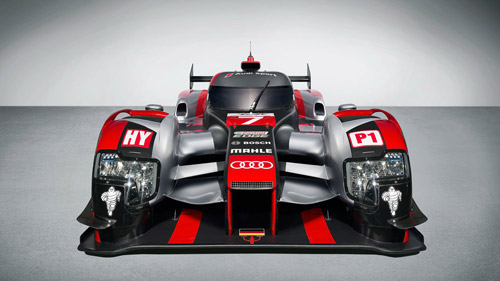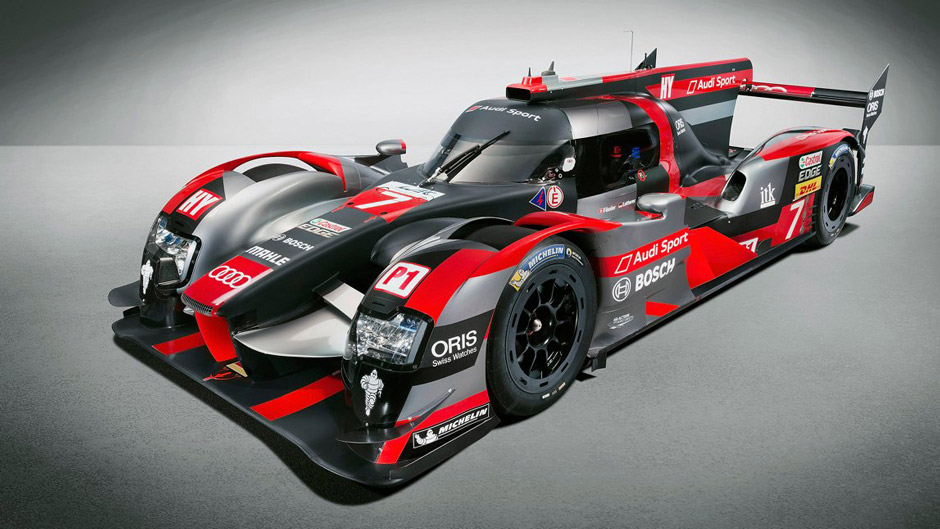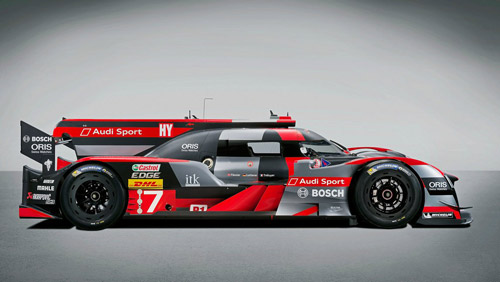
26 Ott Innovation boost for new hybrid sports car

For the FIA World Endurance Championship (WEC) and the Le Mans 24 Hours, Audi is emphasizing focal areas in the 2016 season: The Audi R18 that has been redesigned from scratch has almost nothing in common anymore with its predecessor. It features a more radical aerodynamics concept, including a new safety cell, its hybrid drive system is battery-operated for the first time, the V6 TDI engine has been revised, and new system solutions have been added. As a result, Audi’s LMP1 sports car is a vehicle that is more powerful and – once more – clearly more efficient than its predecessor. While the new R18 is Audi’s strongest race car to date, it consumes less fuel than any of the generations before it.
Power output of more than 1,000 hp delivered by the TDI and hybrid powertrain, ten percent less fuel consumption than before – Audi is achieving new best marks under the efficiency regulations. The FIA WEC regulations have been providing automobile manufacturers with incentives to build increasingly efficient race cars since 2014. Starting in the 2016 season, this competition will intensify, as the upper limit for fuel consumption will considerably decrease by 10 megajoules per lap at Le Mans. “The result is a race car that manages energy even more effectively than before. This is an objective we’re pursuing for our road-going automobiles as well,” says Head of Audi Motorsport Dr. Wolfgang Ullrich. “This type of motorsport continues to set an example for automotive engineering. For Audi, production relevance has been a core topic of all racing programs for 35 years.”
All development engineers at Audi Sport were challenged to enhance the efficiency of the Audi R18. As a result of switching to the 6-megajoule class, the hybrid system, due to the regulations, now recovers 50 percent more energy. The car’s aerodynamics concept is fundamentally new. Nearly all vehicle systems have been refined or redesigned. Consequently, energy consumption decreases, the race car has become lighter, and allows for more favorable packaging of the component assemblies. This has resulted in an R18 which even visually clearly differs from its predecessor.
New structure for optimized aerodynamics
No other race car embodies the philosophy of optimized aerodynamics as consistently as the LMP1 sports cars that render a futuristic impression. When looking at the new Audi R18, a significantly altered exterior strikes the eye. The proportions of the front end and the cabin within the overall vehicle length have changed and the conspicuous nose of the race car is clearly slimmer than before.
“The new proportions influence weight distribution and aerodynamics,” explains Jörg Zander, Head of Engineering at Audi Sport. “Our most important objective was to improve airflow.” At the front end, airflow has to be directed across the top of the race car and between the wheel wells, enter the cooling ducts through the body shell, and optimally approach the underfloor. “In this process, vortices must be avoided, as this costs energy,” says Zander. Undesirable vortices and turbulent flow would reduce the energy in the airflow and increase resistance. The smaller the space which the monocoque – the central stressed structure and safety cell of the race car – occupies in this area the larger are the clearances for low-loss airflow. Thanks to the new proportions, the new Audi R18 directs airflow even more effectively to optimally approach the underfloor. At the rear, the air exits again through the diffusor. As a result, it produces a major portion of the downforce under the race car, which is beneficial in cornering. Audi developed a new monocoque, modified the proportions within the prescribed maximum length of 4,650 millimeters, and designed all the component assemblies accordingly.
New as well are the dimensions and positions of the prescribed openings in the front wheel arches. They are intended to reduce undesirable aerodynamic lift effects in the case of lateral airflow. Their areas have been enlarged by 45 percent compared with the 2015 season.
 Creative detailed solutions in the chassis
Creative detailed solutions in the chassis
This new concept requires innovations in many other areas. The suspension is a case in point. Due to the new monocoque, the mounting points for the front suspension have significantly changed. To make them more compatible with the position of the drive shaft for the hybrid system, the new mounting points have been rearranged. Suspension kinematics has been significantly revised. Wishbones featuring a new design are now used for wheel guidance. The lift and roll spring-damper elements are actuated via pushrods at the front. The rear suspension kinematics has been optimized as well. As in the case of the previous-generation vehicle, the spring-damper elements are controlled using pullrods. Optimum balance of the race car in all speed ranges is guaranteed by balancers of the Linked Suspension System (LSS) in the chassis.
The transmission is a new design as well. Audi’s simulations revealed that the optimized engine allows a very good gear ratio spread with minimal rpm jumps even in combination with a six-speed instead of the previous seven-speed unit. As a result, the engineers managed to further reduce the weight of the transmission. In the other areas of the vehicle’s structure, Audi rigorously pursued its lightweight design approach as well, while retaining the high torsional stiffness of the chassis.
In addition, new solutions for the actuators of individual systems of the Audi R18 help reduce weight. While in the previous-generation vehicle electrical actuators were still operating in the braking, transmission and engine systems, the new Audi R18 uses an all-new development of a high-pressure central hydraulic system. The regulations prescribe a minimum weight of 875 kilograms for the LMP1 hybrid sports cars. In spite of a more powerful and therefore necessarily heavier hybrid system, Audi does not exceed this limit.
New approaches to hybrid drive
Hybrid pioneer Audi, the first manufacturer to have won the Le Mans 24 Hours with an energy recuperation system, was using a flywheel energy storage system from 2012 to 2015. Now the time is ripe for the next step. In the future, a battery will be accumulating the energy. Electrokinetic technology is being replaced by an electrochemical storage system. “The flywheel accumulator definitely proved viable for the lower energy classes,” explains Thomas Laudenbach, Head of Electrics, Electronics and Energy Systems at Audi Sport. “But due to the fact that we now have to process even more energy than before, a technology change suggested itself.” The previous flywheel accumulator guaranteed high power density. Now, favorable energy density has to be achieved as well, as Audi is switching to a higher hybrid energy class. Starting in the 2016 season, the amount of energy will increase by 50 percent to 6 megajoules. When comparing this level with the one from the 2014 season, the engineers have even tripled the amount of recuperated energy within this period of time.
For the first time, Audi will be relying on a lithium-ion accumulator as the hybrid energy storage system. Since 2009, the batteries for the electrical system of the LMP sports cars with the four rings have been based on this technology. The production-based cells of the new hybrid storage system use advanced and powerful cell chemistry and are serially connected. The system is located within the high-strength safety structure in the monocoque and separately encapsulated once more. Electrical and electronic safety systems monitor various parameters – from individual cells through to the overall high-voltage system – and will intervene if necessary. The shutoff logic naturally includes crash detection.
The energy stored by the system is generated by an MGU (Motor Generator Unit) at the front axle. The Audi R18 converts the rotary motion of the front wheels into electrical energy when the driver brakes before entering a turn and feeds it into the storage system. This way, the hybrid sports car utilizes energy that would otherwise be lost. If the race driver accelerates again on exiting the turn, the current flows in the opposite direction to power the MGU. As a result, the front axle of the R18 helps accelerate the race car again. A low-temperature cooling circuit, which is separate from the engine cooling system, cools the battery cells, MGU, and power electronics.
From the 2016 season on, there will be a track-specific limitation imposed on power output in addition to the previous energy classes. Although the MGU may recuperate any desired amount of energy, it may now only supply 300 kW (408 hp) in the race at Le Mans. Audi has designed its MGU for an output of more than 350 kW (476 hp) in order to recover as much energy as possible. The reason is that even when braking at high speed, the braking phases of an LMP1 race car last only three to five seconds. The high system output helps efficiently recover the required energy. At Le Mans, the system may only supply 300 kW during subsequent acceleration. Accordingly, the energy from the hybrid system will be available for a longer period of time. This limit does not apply to the other FIA WEC rounds.
 By opting for the 6-megajoule class, Audi has presented its most powerful MGU so far. In 2012, Audi started with about 150 kW (204 hp) of electrical power output. To date, this level has far more than doubled. Conceptually, the previous and the new MGU are akin to each other. However, the power electronics, stator, and rotor are new developments. This generation of the hybrid drive system delivers high output and develops strong torque, as a result of which the loads acting on the components that transmit power to the front axle increase accordingly. Audi uses a limited slip differential at the front axle to transfer torque with minimal loss.
By opting for the 6-megajoule class, Audi has presented its most powerful MGU so far. In 2012, Audi started with about 150 kW (204 hp) of electrical power output. To date, this level has far more than doubled. Conceptually, the previous and the new MGU are akin to each other. However, the power electronics, stator, and rotor are new developments. This generation of the hybrid drive system delivers high output and develops strong torque, as a result of which the loads acting on the components that transmit power to the front axle increase accordingly. Audi uses a limited slip differential at the front axle to transfer torque with minimal loss.
Less energy for the powerful and more efficient V6 engine
The developers of the hybrid drive system were allowed to increase output. The engine development team headed by Ulrich Baretzky was confronted with the opposite challenge for the 2016 season. The 4-liter V6 power-plant receives clearly less fuel, which initially reduces its output. Two factors have to be considered in this respect. Audi switched to a higher hybrid energy class – and the regulations allocate less fuel to race cars which recuperate large amounts of energy. This aspect results in a minus of about three percent. At the same time, another change is taking effect. The speed of the LMP1 race cars continually increases. To control it, the officials of the FIA, the WEC and the Le Mans organizer ACO allocate clearly less fuel energy to the hybrid race cars. “This is a development which, as a manufacturer, we principally support in order to control the lap times,” says Dr. Wolfgang Ullrich.
The basic concept of the V6 TDI engine dates to 2011. With its double-flow VTG mono turbocharger, 120-degree cylinder bank angle, the exhaust gas side within the V angle, and innovative detailed solutions the unit tends to be regarded as unusual. The initial displacement volume of 3.7 liters increased to four liters in 2014. “We’re now using the basic engine concept for the sixth consecutive year. This shows how sound the basic idea still is,” says Ulrich Baretzky. “Due to efficiency increases, we partially compensate for the lower amount of fuel.”
Among other things, the turbocharger is now lighter and more efficient. Externally, the V6 TDI has changed as well. Individual components are now arranged differently in order to make room for the new aerodynamics concept. The prescribed limitation of the charge pressure to a factor of 4 does not change the engine’s torque of more than 850 Newton meters. The higher efficiency pays off, as the fuel cell capacity of the race car has been reduced further as well – by eight percent to 49.9 liters.
Overall concept clearly more efficient
The efficiency increases of the race car are remarkable in a historic comparison. The current V6 TDI consumes 32.4 percent less fuel than the first generation did in 2011. This progress is even more substantial in a comparison with the original year of 2006. Back then, Audi used TDI technology for the first time. Thanks to this technology, the brand with the four rings has since clinched eight victories, a distance record, plus two world championship titles. Today, Audi’s LMP1 race car with the current engine uses 46.4 percent less fuel at Le Mans. Still, it achieves lap times that are ten to 15 seconds better than a decade ago. All of this is possible thanks to the sum of all the advances that have been made in the areas of aerodynamics, lightweight design and the powertrain.
Distinctive safety
In terms of safety, the LMP1 race cars will continue to set standards in the future as well. Audi complements the exacting requirements of the regulations by in-house research that far exceeds these rules. In the field of active safety – in other words the detection of hazards and accident prevention – the Audi drivers can draw on a wealth of tools. While the driver information monitor in the cockpit to display race control flag signals is prescribed, Audi assists its drivers with a number of additional solutions. For instance, Matrix LED headlights combined with Audi laser light optimize the light beam of the race cars that can reach speeds of up to 340 km/h. Since 2015, Audi customers have been able to order laser light in the second generation of the Audi R8 as well. Matrix LED technology has been making its way into a growing number of model ranges.
Particularly good rearward vision is provided by a lightweight and energy-efficient camera system in combination with an ultramodern AMOLED screen that serves as a digital rear view mirror. Since the 2001 season, the drivers and pit crews have been keeping their eye on tire inflation pressure using a tire pressure monitoring system. And, last but not least, the Audi R18 automatically controls brake force distribution with respect to the hybrid system in the respective operating condition.
In the event that an accident cannot be avoided, the passive safety systems take effect. The monocoque consists of a high-strength CFRP structure with an aluminum honeycomb core and has a front crash nose for energy absorption. In 2011, Audi was the first manufacturer to use a single-piece monocoque. The cell has been provided with additional side impact protection, as Zylon layers integrated into the cockpit walls prevent the intrusion of objects. In rear-end collisions a CFRP structure at the transmission absorbs the impact energy. Double wheel tethers have been successfully used since the 2014 season and reduce the risk of wheels separating from the race cars in accidents. Due to their rotary motion, wheels have high levels of kinetic energy. The high-voltage protection systems ensure that the electrical currents in the hybrid system can be safely controlled. There is no other motorsport discipline that uses an equal amount of high technology to protect the driver before or during an accident.
Be it in terms of the performance capabilities and safety of the race cars or the furthering of efficiency and innovations: in the sum of all technological features, the LMP1 class remains unique around the globe and therefore of utmost relevance for the future of the automobile.

